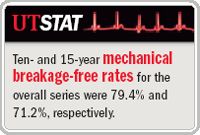Article
Inflatable penile protheses show solid longevity
Atlanta-Long-term survival of inflatable penile prostheses that have been in use over the past 2 decades is excellent, and the reliability of those devices appears even more promising for the enhanced models that have become more recently available, said Steven K. Wilson, MD, at the annual AUA meeting.

Dr. Wilson, professor of urology, University of Arkansas for Medical Sciences, Little Rock, reported results from analyses based on 2,384 patients who underwent first-time implantations with one of four different prosthesis models: Mentor Alpha 1, Mentor Alpha NB (Mentor Corp., Santa Barbara, CA), AMS 700 CX, and AMS 700 Ultrex (American Medical Systems, Minnetonka, MN). All of the surgeries had been performed by a single surgical team, and data on implant type, date, and revision history were entered prospectively into a computerized database.

"In fact, penile implants appear to have better longevity than virtually any other medical device presently implanted, including hips, knees, and pacemakers, among others."
Implants for ED
Dr. Wilson added that another impetus for undertaking the study was to gather statistics that might support stronger consideration of an inflatable prosthesis for managing erectile dysfunction in the current era of medically oriented treatment.
"With the PDE-5 inhibitors being regarded as magic pills, many urologists are overlooking the potential role of IPPs. Our findings on long-term survival show that for patients who fail to respond to medical intervention or who have contraindications to using those medications, an inflatable penile prosthesis might offer an excellent, minimally invasive solution for treating ED," Dr. Wilson said.
Dr. Wilson's database includes nearly 6,000 implant surgeries using 14 different models. The focus of the present analysis was on the four models for which the greatest amount of data were available, and it included first-time implant procedures only to avoid confounding of failure times by prior implants. The survival estimates were derived using the Kaplan-Meier product limit method, and statistical comparisons of rates between enhanced and unenhanced versions were done using the log-rank test. All analyses were performed by an independent third party.
In addition to the revision-free survival rates, Dr. Wilson reported 10-and 15-year mechanical breakage-free rates for the overall series were 79.4% and 71.2%, respectively.
The positive impact of manufacturer-introduced mechanical enhancements was seen in the statistically significantly better survival rates of the enhanced Mentor Alpha and AMS 700 CX models versus unenhanced versions.
"In 1992, Mentor added pump reinforcement to the Alpha model to forestall mechanical breakage. For devices with that modification, the 10-year survival rate was 88.6% compared with 65.3% for previously available models," Dr. Wilson said.
Similarly, the addition of an internal paralyne coating to the cylinders of the AMS CX implant in January 2001 significantly improved the durability of that device, as its 3-year revision-free survival rate was 87.4% compared to 78.6% for historical non-coated inflatables.
"More good news for patients from this large database shows an infection-retardant coating of minocycline and rifampin recently added to AMS IPPs has also decreased the need for reoperation for infection," Dr. Wilson said.

